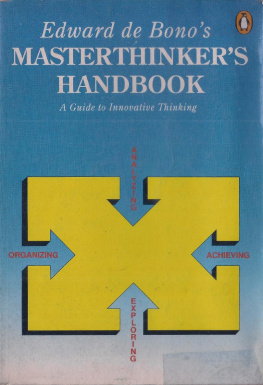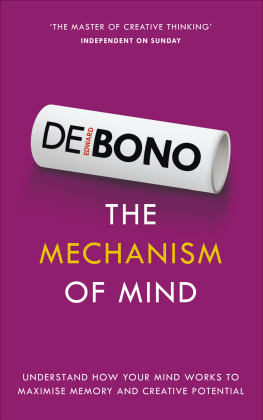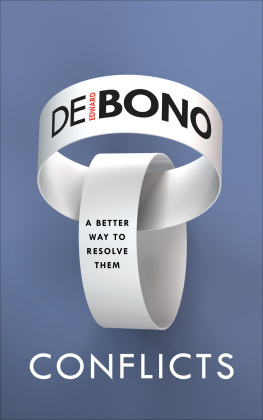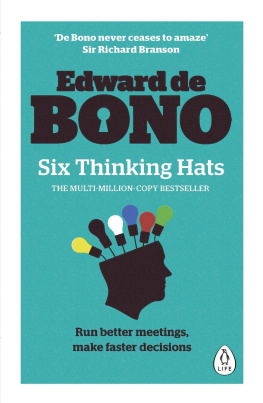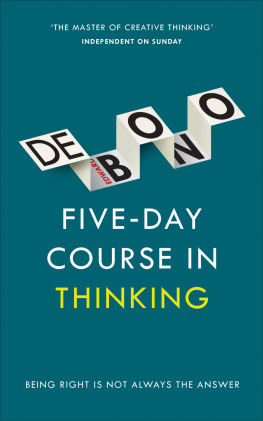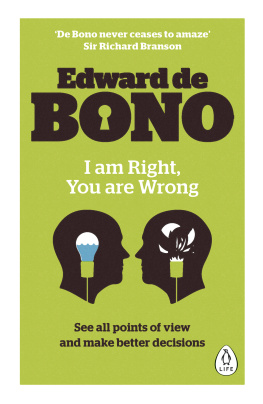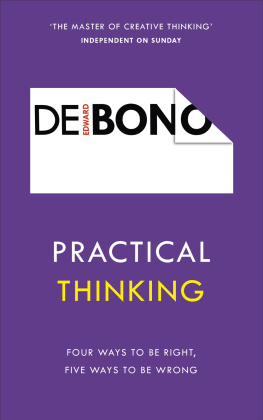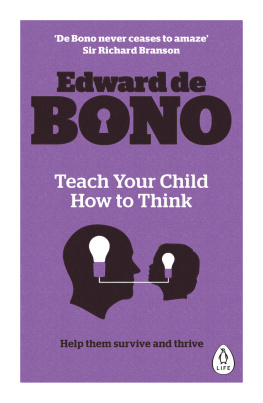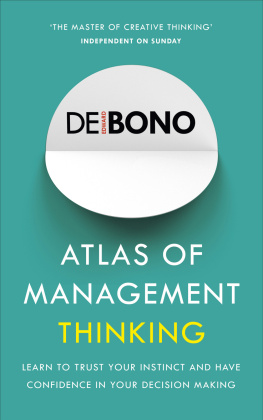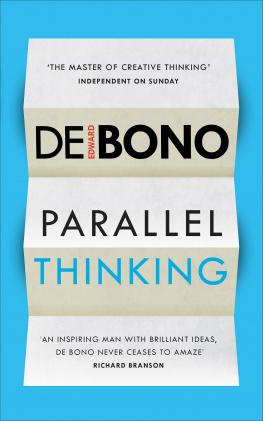Edward De Bono - Edward De Bonos Masterthinkers Handbook: A Guide to Innovative Thinking
Here you can read online Edward De Bono - Edward De Bonos Masterthinkers Handbook: A Guide to Innovative Thinking full text of the book (entire story) in english for free. Download pdf and epub, get meaning, cover and reviews about this ebook. year: 1990, publisher: Penguin, genre: Romance novel. Description of the work, (preface) as well as reviews are available. Best literature library LitArk.com created for fans of good reading and offers a wide selection of genres:
Romance novel
Science fiction
Adventure
Detective
Science
History
Home and family
Prose
Art
Politics
Computer
Non-fiction
Religion
Business
Children
Humor
Choose a favorite category and find really read worthwhile books. Enjoy immersion in the world of imagination, feel the emotions of the characters or learn something new for yourself, make an fascinating discovery.
- Book:Edward De Bonos Masterthinkers Handbook: A Guide to Innovative Thinking
- Author:
- Publisher:Penguin
- Genre:
- Year:1990
- Rating:3 / 5
- Favourites:Add to favourites
- Your mark:
- 60
- 1
- 2
- 3
- 4
- 5
Edward De Bonos Masterthinkers Handbook: A Guide to Innovative Thinking: summary, description and annotation
We offer to read an annotation, description, summary or preface (depends on what the author of the book "Edward De Bonos Masterthinkers Handbook: A Guide to Innovative Thinking" wrote himself). If you haven't found the necessary information about the book — write in the comments, we will try to find it.
Edward De Bonos Masterthinkers Handbook: A Guide to Innovative Thinking — read online for free the complete book (whole text) full work
Below is the text of the book, divided by pages. System saving the place of the last page read, allows you to conveniently read the book "Edward De Bonos Masterthinkers Handbook: A Guide to Innovative Thinking" online for free, without having to search again every time where you left off. Put a bookmark, and you can go to the page where you finished reading at any time.
Font size:
Interval:
Bookmark:
Content
The main difficulty with thinking is confusion. We try to do too much in our minds at once. We need some simple way of paying attention to one thing at a time. In this way we can build up a sort of map. With such a map we know where we are. We can then take appropriate action.
In this book I put forward a new framework which allows a thinker to direct his or her attention to one aspect of a matter at a time. This framework is useful in both reactive thinking (when something is put in front of you) and also in active thinking (when you have to generate the material).
I am very conscious that there are many elaborate schemes for thinking. These are often complex. They look nice in a book. But, very few people can actually remember all the steps, so the schemes tend to remain in the books rather than enter into daily use. That is why my specific purpose in putting forward the framework in this book has been to aim for something that is very simple, very easy to remember, and very easy to use.
I have chosen the 'body' as the framework because we always carry our bodies around with us. It turns out that this analogy of the human body (bones, muscle, nerves, fat) is also a most useful way of looking at thinking. What are the bones of this situation? Where is the muscle in this thinking?
My many years of experience in teaching thinking skills have convinced me that simple frameworks used effectively can be very powerful. The framework put forward in this book can be used to guide your own thinking or it can be used to focus the thinking of others.
A master carpenter is someone who has mastered the art and craft of carpentry. A master carpenter has at his or her fingertips the skills needed to carry out any carpentry task. Such a carpenter decides to do something and then sets out to do it with the confidence that arises from knowing what you need to do and how to do it.
The master carpenter has mastered the skills of carpentry. The masterthinker is someone who has mastered the skill of thinking. Thinking is a skill like any other. You can master it, just as you can master the skills of carpentry or skiing, music, or mathematics.
Far too many people believe that thinking is a matter of intelligence: If you are intelligent you will automatically be a good thinker. This is not so. In fact, many intelligent people are poor thinkers because they fall into the 'intelligence trap' which I shall describe later. On the other hand many people who do not have the highest IQs can become skilled thinkersprovided they set their minds to it.
If we treat thinking as a skill then we can improve thinking just as we can improve any skill through attention and practice.
THE MASTERTHINKER is someone who has developed thinking skill to a high degree. Such a masterthinker is able to direct his or her thinking to any subject whatsoeverjust as that master carpenter can tackle any carpentry task. The masterthinker has command of the tools and methods of thinking. He or she knows what to do, when to do it and how to do it. The result is confidence and effectiveness. The masterthinker sets out to do something and knows that at the end there will be a useful output: The problem will be solved. The plan will be made. The design will be completed. The decision will be finalized.
THE MASTERTHINKER is not concerned with proving himself or herself right and the other person wrong. The masterthinker explores the matter in an objective manner. The masterthinker is always prepared to admit when he or she is wrong. The master thinker is prepared to admit dissatisfaction with the thinking that has taken placeeven when it is his or her own thinking. The masterthinker knows that the thinking is always more important than the thinker. The masterthinker is confident but never conceited. Thinking is a skill that can always be improved.
THE MASTERTHINKER is constructive rather than destructive. He or she is interested in working things out and in making things happen. The masterthinker is cooperative and can work with others in a positive sharing of thinking.
THE MASTERTHINKER knows that human emotions, human feelings, and human values are an essential part of thinking and uses them to make decisions and choices. The masterthinker is a human being not a computer.
THE MASTERTHINKER knows that thinking is the ultimate human resource and that the future of the world depends on our skilled use of that resource.
If you really want to become a masterthinker then there are a number of deliberate steps that you must take. I have listed these steps below.
You have to want to become a masterthinker.
That sounds obviousbut it is not. Very few people really want to become masterthinkers. Most people believe that their thinking is so good that there is nothing they need to do about it. They also feel that there is nothing that anyone could teach them. There is a great deal of complacency about thinking. Then there are those people who are only interested in winning arguments and proving that they are right. For them, thinking is just an extension of their ego. Such people do not want to become masterthinkers because a masterthinker must use thinking in an objective fashioneven when it means admitting that you are wrong.
You have to focus on thinking.
Now this is very difficult. We breathe, we walk, we talk and we think. But we do not really focus on these activities. They just happen as we go along. We do not need to be conscious of every step we take and of every breath we breathe. In the same way we use thinking as we go about our daily business. We do not stop to consider what we are doing. We do not actually focus on our thinkingit just seems to be there. In order to become a masterthinker you do have to focus on your thinking. You must watch yourself thinking and watch others thinking. Thinking must become an area of interest and then a skill area. At the beginning this may seem awkward and unnatural but quite soon it becomes enjoyable. Thinking can be fun as well as useful.
You have to set aside some time for thinking.
We spend most of our time just reacting to information that is put in front of us: at school, on television, in newspapers and magazines, and in our conversations. Of course, all this does involve some thinkingbut not very much. Usually we just let the information pour into us and we hope that it adds up to something in the end. How often do you say to yourself: "I am going to spend some time thinking about this?" People do not like thinking because it seems complicated and unproductive. We just seem to get ourselves into knots. As we develop skill at thinking it gets easier and more enjoyable. This is no different from learning to swim, ski or ride a bicycle. They all seem awkward at first. You have to want to keep going.
You have to have some thinking techniques.
You can order someone to 'think'. That person might try very hardbut not much will happen. You can order yourself to 'think' but not very much will happen. Effort alone is not enough. If it were, we might all be geniuses. We need thinking techniques and methods. It is when we apply these with skill and effort that we get results.
The famous American philosopher William James once said that for most people "thinking was just a re-arrangement of their prejudices". This is quite a good description of what normally passes for thinking. Usually there is no more than a sort of active daydream in which we muse about the situation in the hope that we can spot a solution or course of action. At other times we use "point to point thinking" which means that we move along from one obvious point to the next, ignoring all the important routes along the way. The purpose of this handbook is to provide a set of techniques for thinking. As you go through the book you will find that you are asked to use different frameworks and techniques. There is always something to do, some thinking task to be carried out. In this way thinking becomes a step-by-step process. We take one step after another. This is very different from drifting about and hoping we come across something useful. When you have learned how to use the techniques then you will know what to do when you give yourself the order to 'think about something'. When you are really skilled in the use of the tools then you will be a masterthinker.
Next pageFont size:
Interval:
Bookmark:
Similar books «Edward De Bonos Masterthinkers Handbook: A Guide to Innovative Thinking»
Look at similar books to Edward De Bonos Masterthinkers Handbook: A Guide to Innovative Thinking. We have selected literature similar in name and meaning in the hope of providing readers with more options to find new, interesting, not yet read works.
Discussion, reviews of the book Edward De Bonos Masterthinkers Handbook: A Guide to Innovative Thinking and just readers' own opinions. Leave your comments, write what you think about the work, its meaning or the main characters. Specify what exactly you liked and what you didn't like, and why you think so.

